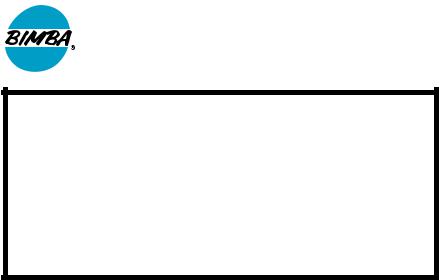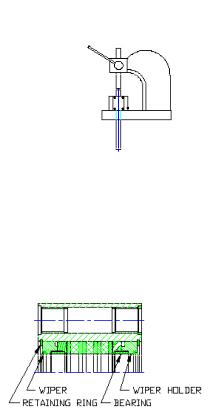Bimba Ultra Slide Rodless Cylinder User Manual

Bimba Ultran® Slide Rodless Cylinder
Repair Instructions
CAUTION!
The magnets used in the Ultran product line are of an extremely high strength and brittle material. Caution should be used in handling these magnets.
If the magnets are cracked due to impact fractures during the repair process, they will repel each other and fly apart.
During the repair of the product, be sure your fingers do not get between the piston and the carriage. The magnets on both these parts will attract each other and could cause injury.
NOTES
•Cleanliness of the internal parts is imperative for maximum life of the slide unit.
•Parts that have been repaired should be covered or bagged until needed for finished assembly.
•Any high grade of bearing grease should be used for lubrication purposes.
Tools required: knife or wire cutters hex driver
arbor press screwdriver retaining ring pliers torque wrench
plastic bags or clean containers to hold parts during the repair lubricant
NOTE on Arbor Press: Using an arbor press is the safest and preferred way to perform some of the operations in these instructions. Pressing through the body’s length is necessary, so the arbor press must have its table a distance from the floor that is equal to or greater than the stroke of the cylinder. A proper repair is unlikely if these warnings are not followed.

SLIDE REPAIR INSTRUCTIONS
Refer to Figure 1 for Steps 1–7
1.Remove air pressure and fittings. Figure 1:
2.Wipe down and clean the unit.
3.Remove the four cap screws that fasten the end blocks to the guide rods.
4.Remove the end blocks and the guide rods keeping the carriage, body and piston together as a unit.
5.Remove any grease, dirt or oil from the individual pieces.
6.Place the carriage, body and piston assembly in an arbor press. Using a non–magnetic rod or shaft,
press on the piston to uncouple it from the carriage magnets. Do not let the body slip out of the carriage during this operation.
7.Remove the carriage from the body leaving the piston inside the body. Place body and piston aside.
Refer to Figure 2 for Steps 8–12
8.Remove retaining ring, wiper holder
and bearing from the center hole on the Figure 2: carriage. Repeat for both ends.
9.Insert new bearings into both ends.
10.Noting the orientation of the wiper lip, remove the old wiper from wiper holder and insert new wipers with the same orientation.
11.Insert the wiper holder into carriage.
12.Assemble the retaining ring into its groove in the carriage.
Refer to Figure 3 for Steps 13–17
13.Plug the center hole of the carriage (both ends) with a clean rag or cloth to prevent bearing contamination.
14.Pry out the four guide shaft wipers or press rings (depending on bore size and/ or option) with a screw driver or similar tool.
15.Press out the four guide shaft bearings using care not to disturb the internal press rings.
16.For the 3/4” thru 2” bore sizes, press in the new guide shaft bearings to the bottom of the counterbore using an arbor press. For the 5/16” thru 9/16” bore sizes, press the bearing into the dimension shown in the chart.
17.Press in the new wipers or press rings, depending on bore size and/or options.
